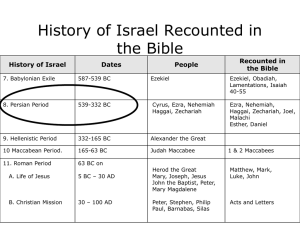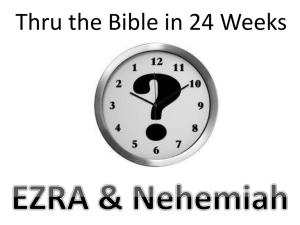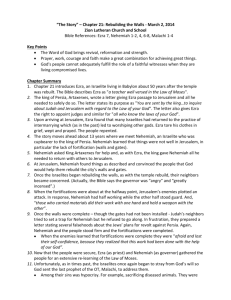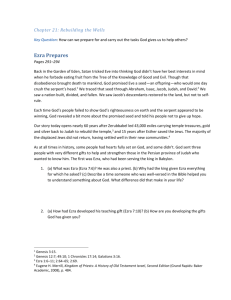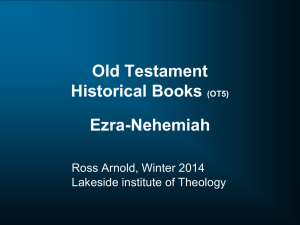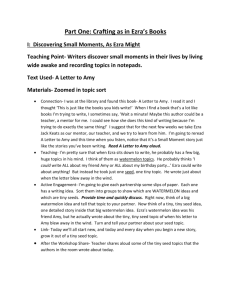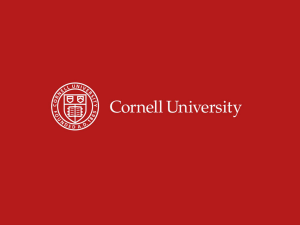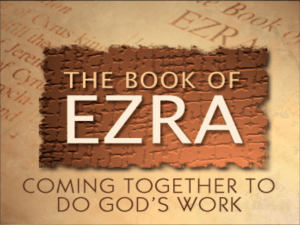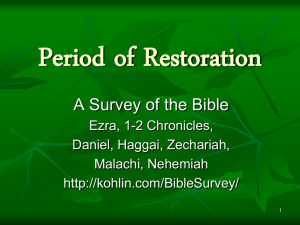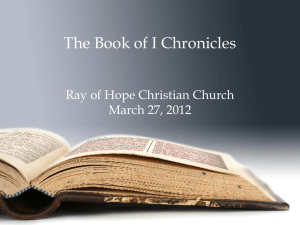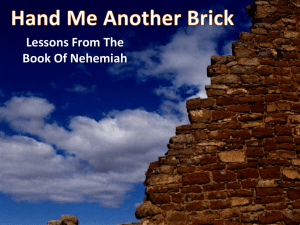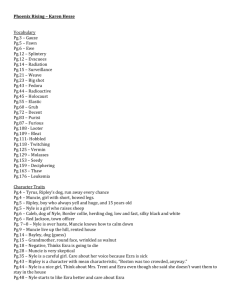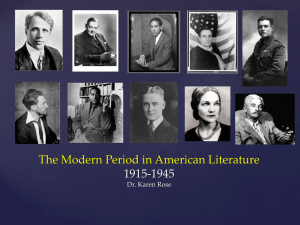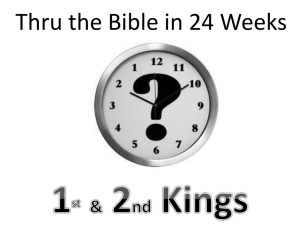Ezra-Nehemiah
advertisement
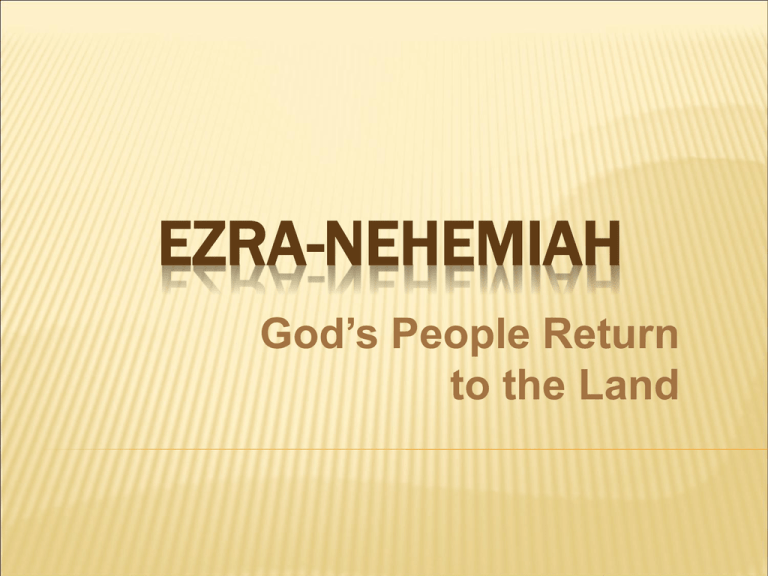
EZRA-NEHEMIAH God’s People Return to the Land EZRA - GENERAL INTRODUCTION Ezra continues the OT narrative of 2 Chronicles by showing how God fulfills his promise to return His people to the Land of Promise after 70 years of exile. The return is viewed as a “second exodus,” but, this time, from Babylon. EZRA Ezra relates the story of two returns from Babylon: 1) The first led by Zerubbabel to rebuild the Temple (chaps. 1-6) 2) The second under the leadership of Ezra to rebuild the spiritual condition of the people (chaps. 7-10) EZRA Ezra and Nehemiah were treated as a unit in the original Hebrew as and in the Septuagint. The two were separated in the Latin translation, and English translations have likewise treated them as separate works. AUTHORSHIP Although not specifically mentioned as the author, Ezra is the best candidate. The Talmud attributes the book to Ezra, and portions of the book (7:28-9:15) are written in the first person, from Ezra’s point of view. There is a strong priestly emphasis, and Ezra was a direct priestly descendant of Aaron through Eleazar, Phineas, and Zadok. DATE Just as the Israelites were taken into exile in three stages (605,597,586 B.C.), they returned in three stages. 1) The first occurred under the leadership of Zerubbabel (c. 538 B.C.). After a long delay, the Temple was rebuilt (c. 520-516 B.C.), encouraged by the prophets Haggai and Zechariah. DATE 2) Ezra led the second return in the year of Artaxerxes I (c. 458 B.C.) 3) Nehemiah led the final return in the twentieth year of Artexerxes I (c. 444 B.C.) Ezra probably wrote this book between 457 B.C. (The events of chapters 7-10) and 444 B.C. (Nehemiah’s arrival in Jerusalem). THEME AND LITERARY STRUCTURE Ezra divides his book into two sections: 1) The Restoration of the Temple (Chaps. 1-6) 2) The Reformation of the People (Chaps. 7-10) THEME The basic theme of Ezra is restoration. This theme is played out in the restoration of the temple and the spiritual, moral and social restoration of the returned remnant in Jerusalem under the leadership of Zerubbabel and Ezra. Both are undertaken despite opposition and difficulty. CONTEXT The restoration of temple and people required a reassertion of the distinctive identity of Israel and her faith, together with separation from other peoples and pagan beliefs. This restoration was taking place in the context of the Persian empire, in which the dominant religious tendency was the merging of religious beliefs into one. CONTEXT In this context, the reestablishment of a temple worship purified of pagan religious influences and the purification of the people from intermarriage with other peoples were both necessary. EZRA’S REFORMS 1) The problem of foreign wives (9-10) Discovering that many of the Jews had married non-Jewish women, Ezra tore his clothes, pulled his hair, and went into a state of mourning. Those who had married non-Jewish women divorced them and sent them away with any children born to them. EZRA’S REFORMS 2) The Renewing of the Covenant (Neh. 8-9) Ezra called the people together for a covenant renewal ceremony. First, there was the reading of the Torah (in Hebrew) Second, the Scriptures were translated into Aramaic (the language of the people). This is the first recorded attempt to paraphrase the Scriptures into Aramaic. NEHEMIAH Nehemiah was a contemporary of Ezra, and cupbearer to the king of Persia. He led the third return to Jerusalem from exile. He gained the king’s permission to return to Jerusalem and lead his people in rebuilding the walls of Jerusalem. The task was completed in 52 days, while the task of reviving and reforming the people of God demanded years. AUTHORSHIP Because of the close connection between Ezra and Nehemiah, many scholars believe that the same person compiled both books, probably Ezra. Neh. 1:1 describes the contents as being “the words of Nehemiah.” The narrative is also in first person, so Ezra, as compiler, was apparently quoting from the writings of Nehemiah. AUTHORSHIP Nehemiah was the cupbearer to King Artexerxes. This was more like an advisor than a butler. That the king made Nehemiah the governor of Judah bears witness to his administrative abilities. DATE The book of Nehemiah focuses on the events surrounding the third return from Exile, in 444 B.C. Nehemiah served twice as governor of Judah. His first term lasted 12 years. His second term began prior to 424 B.C. (The death of the king). Thus the book was probably written between 430 and 420 B.C. THEMES AND STRUCTURE The book of Nehemiah completes the historical account of God's people in the OT. This is about 400 years before the birth of the promised Messiah. The book is divided in two sections: The reconstruction of the wall (1-7) The restoration of the people (8-13) CONTENTS o While Ezra deals with the religious restoration of Judah, Nehemiah is primarily concerned with Judah's political and geographical restoration. o Great attention is devoted to the rebuilding of Jerusalem’s walls, for the city was the spiritual and political center of Judah. CONTENTS o Prominent in the book of Nehemiah is the concept of God's covenant with his people. o Neh. 9:1-10:39 records a covenant renewal ceremony in which the people commit themselves to separate from the Gentiles in marriage and to obey God's commands. NEHEMIAH THE LEADER Nehemiah’s leadership skills are seen in how he organized the rebuilding of the walls. 1) He prayed (1:4-5). 2) He was committed to the project (2:4-5) 3) He conducted a careful survey to see what resources were needed, then he formed a plan. (2:12-16) NEHEMIAH THE LEADER 4) He enlisted others to help him (2:17-18) 5) He faced opposition and dealt with it (2:19- 20). 6) He faced ridicule (4:6), yet he continued. Therefore, Nehemiah persevered. Post-exilic Jerusalem

